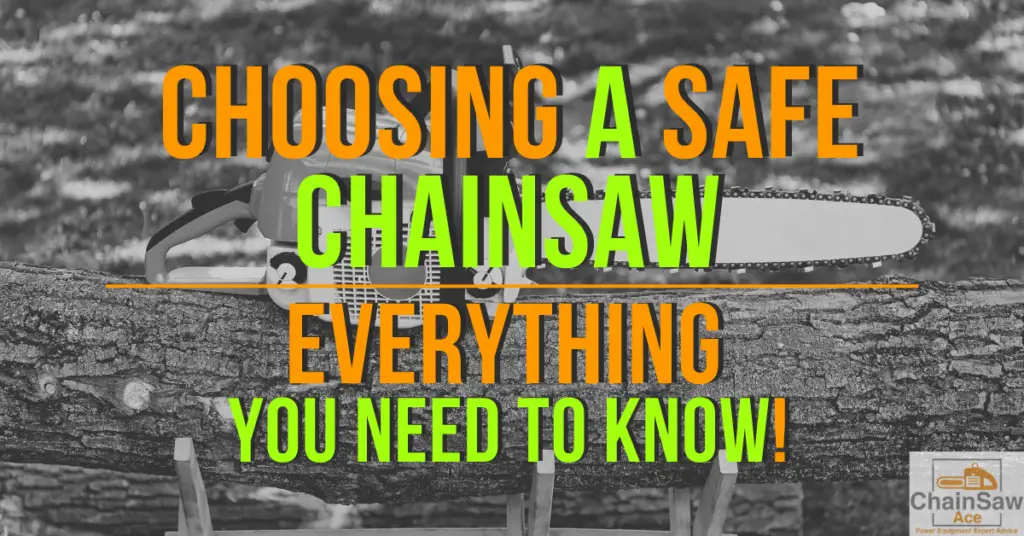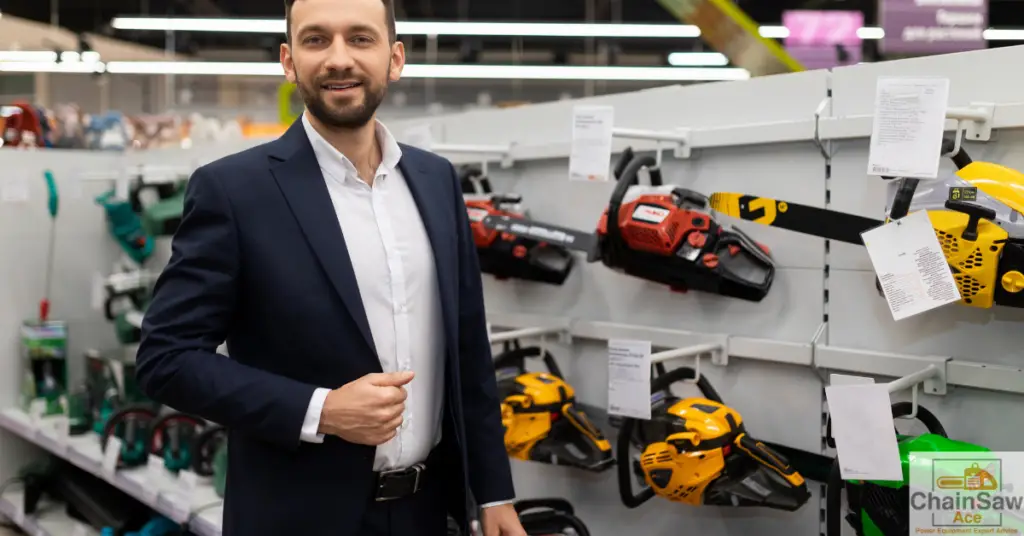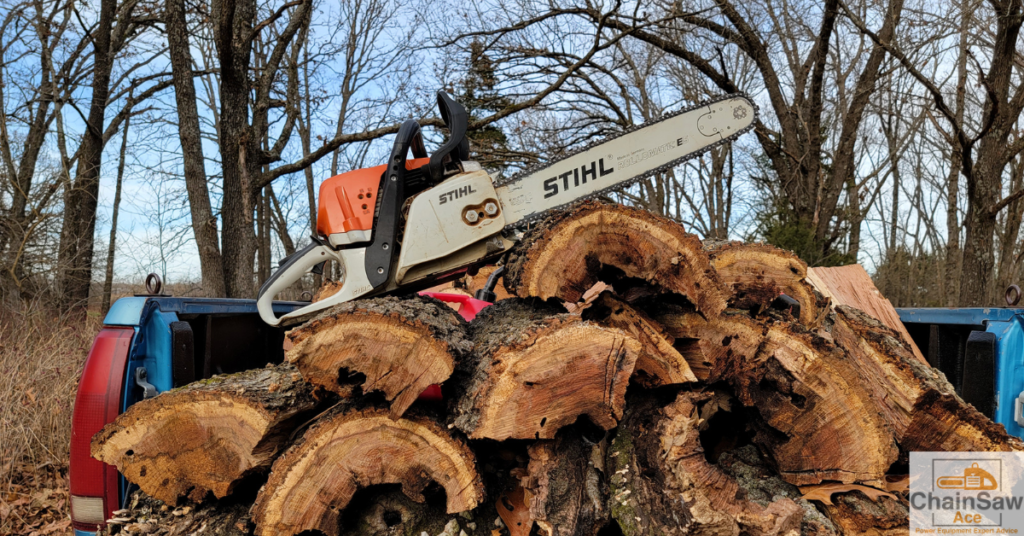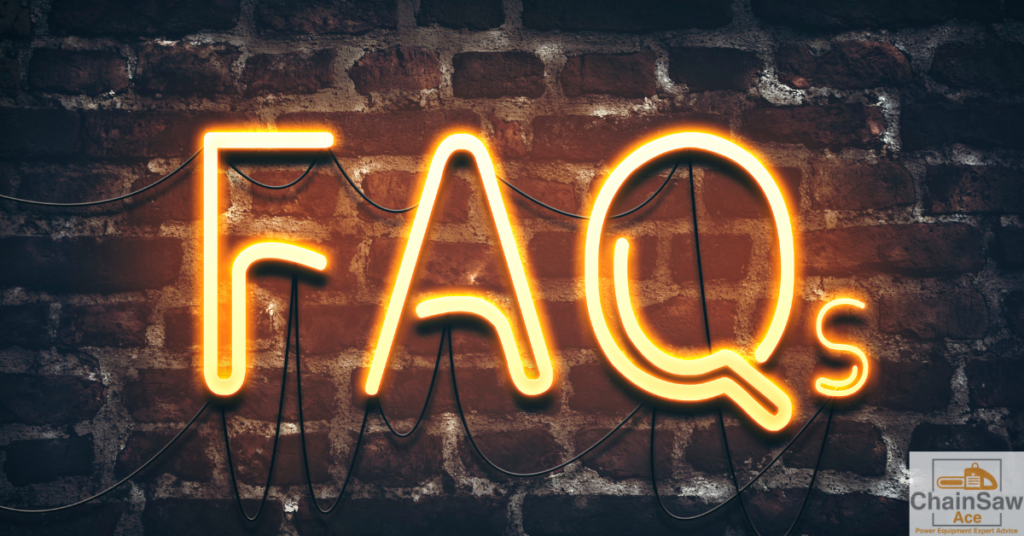
For many, a chainsaw is an indispensable tool. Whether you’re felling large trees, cutting firewood, or just pruning bushes, a chainsaw is often the best tool for the job. There’s a chainsaw for nearly every type of job, from small electric models perfect for light yard work to heavy-duty gas-powered saws capable of tackling the largest of trees.
Choosing the right chainsaw can be a daunting task, but this guide will simplify the process for you.
Our Top Chainsaw Picks
| Image | Title | Price | Prime | Buy |
|---|---|---|---|---|
 | Gas Chainsaw Pick: Husqvarna 450R 450 Rancher Gas Chainsaw, Orange | PrimeEligible | Buy Now | |
 | Corded Electric Chainsaw Pick: Oregon CS1500 18-inch 15 Amp Self-Sharpening Corded Electric Chainsaw, with Integrated Self-Sharpening System (PowerSharp), 2-Year Warranty, 120V | PrimeEligible | Buy Now | |
 | Battery Chainsaw Pick: EGO Power+ CS1604 16-Inch 56-Volt Lithium-ion Cordless Chainsaw - 5.0Ah Battery and Charger Included , Black | PrimeEligible | Buy Now | |
 | Polesaw Pick: Sun Joe SWJ806E 8-Inch 8.0 Amp 2-in-1 Convertible Pole Chain Saw, Green | PrimeEligible | Buy Now |
- Different Types of Chainsaws
- Factors to Consider When Buying a Chainsaw
- Comparing Chainsaw Brands: Husqvarna vs. Stihl
- Chainsaw Maintenance and Techniques for Safe Use
- Wrapping Up
- FAQs
- How to pick a chainsaw?
- What are the types of chainsaws?
- How to choose the right chainsaw?
- What factors should I consider when buying a chainsaw?
- How do I pick the perfect chain saw?
- What are the safety features to look for in a chainsaw?
- How do I choose the right size chainsaw for my needs?
- What are the different power options for chainsaws?
- What are the features to consider when buying a chainsaw?
- What is the best chainsaw for home use?
- What is the difference between Husqvarna and Stihl chainsaws?
- Is an 18 or 20-inch chainsaw better?
- How do I choose a chainsaw that fits my needs and requirements?
- What are the recommended chainsaw brands and models?
- What are some tips for safe chainsaw techniques?
- What are the advantages of gas chainsaws over electric models?
- What should I consider when choosing a chainsaw bar length?
- How do I maintain my chainsaw for safe and efficient use?
- Can I use a chainsaw for tasks other than cutting trees?
- Are corded models better than battery chainsaws?
- How important is the anti-vibration feature in a chainsaw?
- What type of chainsaw is best for cutting firewood?
- How can I increase the cutting speed of my chainsaw?
- What should I consider when buying a new chainsaw?
- What is a pole saw, and what is it used for?
- Can I use a chainsaw for pruning bushes?
- What should I do if the chainsaw’s cutting bar gets stuck in a tree trunk?
- How often should I replace the chainsaw bar?
- How to pick the perfect chain saw for felling trees?
Different Types of Chainsaws
There are several different types of chainsaws on the market, each with its own unique advantages and drawbacks.
Gas Chainsaws
Gas chainsaws are among the most common. They’re powerful and versatile, making them ideal for heavy-duty jobs. Gas-powered chainsaws are typically powered by a two-stroke engine and require a mix of gasoline and oil for fuel.
They are usually heavier and noisier than electric models, but they offer more power and port
The chainsaw size and power output vary widely, from smaller models perfect for home use to larger saws used by professionals. One drawback of gas saws is that they require regular maintenance and have a larger environmental footprint compared to their electric counterparts.
Electric Chainsaws
Next up are electric chainsaws. These tools are powered by an electric motor, making them significantly quieter and easier to start compared to gas saws.
Electric saws are also lighter, making them a good option for those who may struggle with the weight of a gas chainsaw.
However, electric chainsaws require a nearby power source, limiting their range.
Battery Powered Chainsaws
Battery-powered chainsaws are another popular option.
These chainsaws offer the mobility of gas chainsaws without the need for gasoline as well as the environmental advantages of corded electric chainsaws.
However, their running time is limited by battery life, and they’re often less powerful than gas or corded electric models.
Pole Saws
Lastly, pole saws. These chainsaws are mounted on an extension pole, making them perfect for cutting small branches and pruning limbs that are out of reach.
Pole saws come in gasoline-powered and battery-powered varieties. The long reach of pole saws makes them ideal for pruning trees and shrubs that are out of reach.
Using a pole saw is much safer than using a chainsaw on a ladder to reach high-up limbs and branches.
Factors to Consider When Buying a Chainsaw

Chainsaw Size and Bar Length
When looking for a new chainsaw, it’s important to consider the chainsaw size and bar length. The bar length is the active cutting area and determines how large a tree or branch the chainsaw can cut.
For smaller tasks like cutting firewood or trimming small trees, a smaller chainsaw with a bar length of 12-14 inches might suffice. For larger tasks like felling trees, a larger chainsaw with a bar length of over 20 inches may be necessary.
Power Options
Another critical factor is power options. Gas-powered chainsaws are often more powerful but require more maintenance and are heavier.
Electric chainsaws, on the other hand, are lighter and easier to use but may not have the same cutting power and require a nearby power source.
Battery-powered chainsaws provide a balance of mobility and ease of use, but they can be limited by battery life.
Chainsaw Safety Features
Chainsaw safety should be a paramount concern when choosing a chainsaw. Look for features like a chain brake, which can stop the chain if kickback occurs, and anti-vibration features, which can reduce fatigue and make the chainsaw safer and more comfortable to use.
Intended Usage
Finally, consider your intended usage. For heavy-duty tasks like felling large trees or cutting thick logs, a gas-powered chainsaw with a long cutting bar is likely the best choice.
For smaller tasks like pruning bushes or cutting small branches, an electric or battery-powered chainsaw might be more appropriate.
If you need to reach high branches, a pole saw might be your best bet.
Comparing Chainsaw Brands: Husqvarna vs. Stihl

When it comes to chainsaw brands, two names often come up: Husqvarna and Stihl. Both brands offer a range of chainsaw sizes, from smaller chainsaws for home use to larger saws for professional use.
While both brands have their fans and their own unique features, choosing between them often comes down to personal preference and specific needs.
Chainsaw Maintenance and Techniques for Safe Use
Even the safest chainsaw can be dangerous if not used correctly. Proper chainsaw techniques and regular maintenance, such as keeping the chain sharp and ensuring the air filter is clean, are essential for safe and efficient use.
Always wear appropriate safety gear when using a chainsaw, including safety glasses, gloves, and sturdy footwear.
Wrapping Up
Choosing the right chainsaw can seem complicated, but by understanding the different types and considering your needs and safety, you can find the perfect saw for your job.
Whether you choose a gas, electric, or battery-powered chainsaw, remember to always prioritize safety and maintain your chainsaw properly to ensure it serves you well for years to come.
Have a great day out there, and remember to respect your chainsaw.
Steven R.
FAQs

How to pick a chainsaw?
Picking a chainsaw depends on your needs. Consider factors like power source – gas, corded electric or battery powered, chainsaw size, bar length, and intended usage.
What are the types of chainsaws?
The main types of chainsaws are gas, electric, battery-powered, and pole saws.
How to choose the right chainsaw?
Choosing the right chainsaw involves considering your needs, the chainsaw’s power source – gas or battery-powered options – and saw size and safety features.
What factors should I consider when buying a chainsaw?
When buying a chainsaw, consider the power source, chainsaw size, bar length, safety features, and your intended usage.
How do I pick the perfect chain saw?
The perfect chainsaw for you depends on your specific needs and preferences. Consider the tasks you’ll be using the chainsaw for, the power source you prefer, and the size of chainsaw that you can comfortably handle.
What are the safety features to look for in a chainsaw?
Important safety features to look for in a chainsaw include a chain brake, anti-vibration features, and trigger locks.
How do I choose the right size chainsaw for my needs?
The right size chainsaw for your needs depends on the tasks you’ll be using it for. Smaller tasks may only require a smaller chainsaw with a shorter bar length, while larger tasks may require a larger chainsaw with a longer bar length.
What are the different power options for chainsaws?
The main power options for chainsaws are gas, electric, and battery-powered. Each has its own advantages and disadvantages.
What are the features to consider when buying a chainsaw?
When buying a chainsaw, consider the power source, size, bar length, safety features, and the tasks you’ll be using the chainsaw for.
What is the best chainsaw for home use?
The best chainsaw for home use depends on your specific needs. Electric and battery-powered chainsaws are often good choices due to their lighter weight and ease of use.
What is the difference between Husqvarna and Stihl chainsaws?
Husqvarna and Stihl chainsaws are both high-quality brands with a range of options. Choosing between them often comes down to personal preference and specific needs.
Is an 18 or 20-inch chainsaw better?
Whether an 18 or 20-inch chainsaw is better depends on your needs. A 20-inch chainsaw can handle larger tasks, but an 18-inch chainsaw may be easier to handle.
How do I choose a chainsaw that fits my needs and requirements?
Consider your tasks, the chainsaw’s power source, the chainsaw size you can handle, and the safety features when choosing a chainsaw.
What are the recommended chainsaw brands and models?
Husqvarna and Stihl are often recommended chainsaw brands due to their quality and range of options.
What are some tips for safe chainsaw techniques?
Some tips for safe chainsaw techniques include keeping the chain sharp, wearing safety gear, using both hands to operate the chainsaw, and standing to the side when cutting.
What are the advantages of gas chainsaws over electric models?
Gas chainsaws are generally more powerful and can handle larger tasks than electric models. However, they require more maintenance and are typically heavier.
What should I consider when choosing a chainsaw bar length?
Bar length determines the size of the material a chainsaw can cut in a single pass. A chainsaw with a longer bar can cut larger trees, but it may be heavier and harder to control. Therefore, choose a bar length that matches your most common cutting tasks.
How do I maintain my chainsaw for safe and efficient use?
Regular maintenance includes cleaning the air filter, sharpening the chain, and ensuring the chain tension is correct. Always follow the manufacturer’s instructions for maintenance and care.
Can I use a chainsaw for tasks other than cutting trees?
Yes, chainsaws can also be used for tasks such as splitting logs, cutting firewood, and pruning limbs.
Are corded models better than battery chainsaws?
Corded models offer continuous power without the need for recharging or refueling, making them suitable for longer tasks. However, their range is limited by the length of the cord, and they need a power outlet to operate.
On the other hand, battery chainsaws offer mobility and are great for lighter tasks and short durations.
How important is the anti-vibration feature in a chainsaw?
The anti-vibration feature can significantly reduce user fatigue and make the chainsaw safer and more comfortable to use, especially for prolonged periods.
What type of chainsaw is best for cutting firewood?
For cutting firewood, a gas-powered chainsaw is often the best choice due to its power. However, if you are cutting a small amount of firewood, an electric or battery-powered chainsaw may suffice.
How can I increase the cutting speed of my chainsaw?
Cutting speed can be increased by maintaining a sharp chain, ensuring the chainsaw has enough power for the task, and using proper cutting techniques.
What should I consider when buying a new chainsaw?
When buying a new chainsaw, consider your needs, the power source, the chainsaw size and bar length, and the safety features. Also, take into account the chainsaw’s maintenance requirements and the reliability of the brand.
What is a pole saw, and what is it used for?
A pole saw is a type of chainsaw mounted on a pole, and it is used for pruning tree branches without needing a ladder or climbing the tree.
Can I use a chainsaw for pruning bushes?
Yes, chainsaws can be used for pruning bushes. However, for small and delicate bushes, using a smaller chainsaw or a specialized pruning tool might be more suitable.
Also small branches and brush can also throw a chainsaw chain off the guide bar, so caution must be used.
What should I do if the chainsaw’s cutting bar gets stuck in a tree trunk?
If your chainsaw gets stuck, don’t try to force it out. Turn off the chainsaw and carefully remove it from the tree. If necessary, use a wedge or another tool to help release the chainsaw.
Above all, be aware of your environment, be safe, and use common sense.
How often should I replace the chainsaw bar?
The chainsaw bar should be replaced when it is worn out, damaged, or bent. The frequency of replacement depends on how often you use your chainsaw and the conditions in which it’s used.
Regular inspection and proper maintenance can extend the lifespan of your chainsaw bar.
How to pick the perfect chain saw for felling trees?
When choosing a chainsaw for felling trees, consider the tree size and type. Gas chainsaws often have the necessary power for this task, and the bar length should be longer than the diameter of the tree you plan to fell.





